For the 2025 school year, there are 2 public elementary schools serving 271 students in Lost Hills Union Elementary School District. This district's average elementary testing ranking is 5/10, which is in the bottom 50% of public elementary schools in California.
Public Elementary Schools in Lost Hills Union Elementary School District have an average math proficiency score of 29% (versus the California public elementary school average of 35%), and reading proficiency score of 37% (versus the 45% statewide average).
Minority enrollment is 99% of the student body (majority Hispanic), which is more than the California public elementary school average of 79% (majority Hispanic).
Overview
This School District
This State (CA)
# Schools
2 Schools
7,700 Schools
# Students
271 Students
3,822,920 Students
# Teachers
13 Teachers
174,006 Teachers
Student : Teacher Ratio
21:1
21:1
District Rank
Lost Hills Union Elementary School District, which is ranked #1012 of all 1,925 school districts in California (based off of combined math and reading proficiency testing data) for the 2021-2022 school year.
Overall District Rank
#942 out of 1941 school districts
(Top 50%)
(Top 50%)
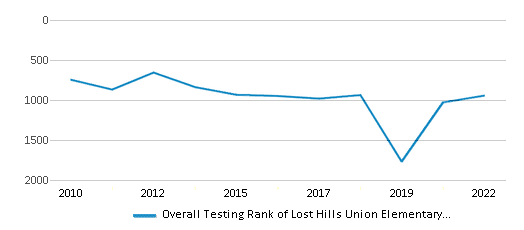
Math Test Scores (% Proficient)
30-34%
33%
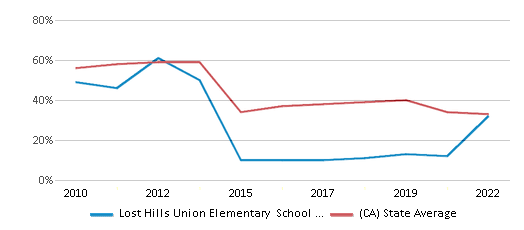
Reading/Language Arts Test Scores (% Proficient)
35-39%
47%
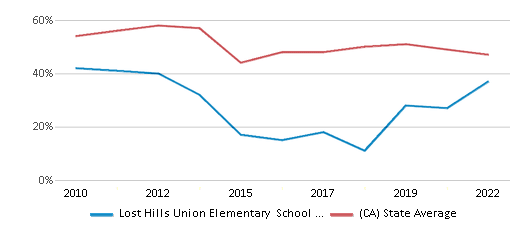
Science Test Scores (% Proficient)
≤10%
29%
Students by Ethnicity:
Diversity Score
0.03
0.64
# American Indian Students
n/a
16,785 Students
% American Indian Students
n/a
1%
# Asian Students
2 Students
454,357 Students
% Asian Students
1%
12%
# Hispanic Students
267 Students
2,114,366 Students
% Hispanic Students
98%
55%
# Black Students
n/a
189,461 Students
% Black Students
n/a
5%
# White Students
2 Students
787,389 Students
% White Students
1%
21%
# Hawaiian Students
n/a
15,077 Students
% Hawaiian Students
n/a
n/a
# Two or more races Students
n/a
240,557 Students
% of Two or more races Students
n/a
6%
Students by Grade:
# Students in PK Grade:
-
83
# Students in K Grade:
41
519,574
# Students in 1st Grade:
28
396,601
# Students in 2nd Grade:
31
414,466
# Students in 3rd Grade:
35
416,628
# Students in 4th Grade:
27
426,360
# Students in 5th Grade:
31
430,582
# Students in 6th Grade:
26
432,936
# Students in 7th Grade:
28
312,207
# Students in 8th Grade:
24
312,649
# Students in 9th Grade:
-
44,929
# Students in 10th Grade:
-
37,487
# Students in 11th Grade:
-
37,249
# Students in 12th Grade:
-
41,169
# Ungraded Students:
-
-
District Revenue and Spending
The revenue/student of $36,494 is higher than the state median of $19,974. The school district revenue/student has grown by 6% over four school years.
The school district's spending/student of $37,103 is higher than the state median of $18,396. The school district spending/student has grown by 6% over four school years.
Total Revenue
$10 MM
$116,387 MM
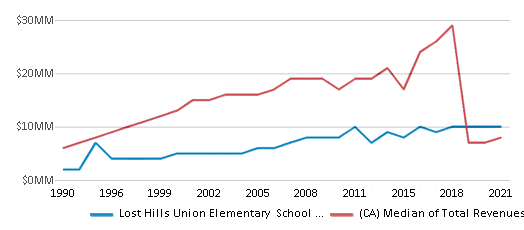
Spending
$10 MM
$107,188 MM
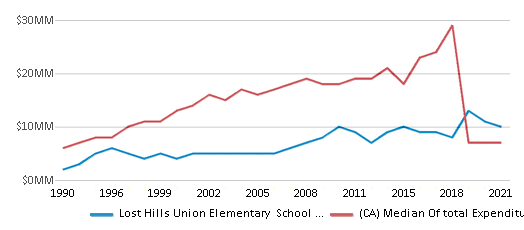
Revenue / Student
$36,494
$19,974

Spending / Student
$37,103
$18,396

Best Lost Hills Union Elementary School District Public Elementary Schools (2025)
School
(Math and Reading Proficiency)
(Math and Reading Proficiency)
Location
Grades
Students
Rank: #11.
Lost Hills Elementary School
(Math: 30-34% | Reading: 35-39%)
Rank:
Rank:
6/
Top 50%10
14821 Primary Ct.
Lost Hills, CA 93249
(661) 797-2626
Lost Hills, CA 93249
(661) 797-2626
Grades: K-5
| 193 students
Rank: #22.
A. M. Thomas Middle School
(Math: 25-29% | Reading: 35-39%)
Rank:
Rank:
5/
Bottom 50%10
20979 Lobos Ct.
Lost Hills, CA 93249
(661) 797-2626
Lost Hills, CA 93249
(661) 797-2626
Grades: 6-8
| 78 students
Recent Articles

Year-Round Or Traditional Schedule?
Which is more appropriate for your child? A year-round attendance schedule or traditional schedule? We look at the pros and cons.

Why You Should Encourage Your Child to Join a Sports Team
Participating in team sports has a great many benefits for children, there is no doubt. In this article you will learn what those benefits are.

White Students are Now the Minority in U.S. Public Schools
Increasing birth rates among immigrant families from Asia and Central and South America, combined with lower birth rates among white families, means that for the first time in history, public school students in the United States are majority-minority. This shift in demographics poses difficulties for schools as they work to accommodate children of varying language abilities and socio-economic backgrounds.





